Figures & data
Table 1 Patient characteristics (N=318)
Figure 1 Changes in HbA1c by visit, diabetes status, body mass index (kg/m2) reduction, and procedure type after bariatric surgery.
Abbreviations: BMI, body mass index; HbA1c, hemoglobin A1c; LS-means, least squares-means.

Table 2 Factors associated with the change in HbA1c using mixed-effects model
